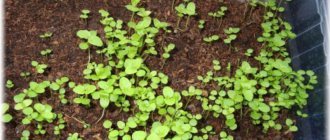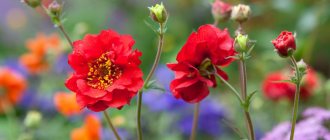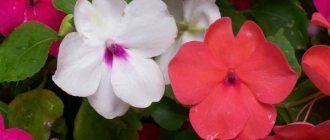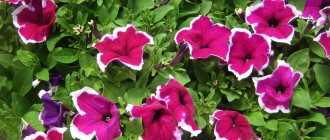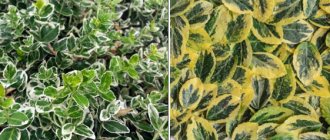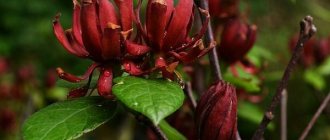Caring for tuberous begonia at home
Begonia is an easy flower to care for, and you can certainly grow a beautiful flowering plant if you follow a few growing rules.
What time of year is best to plant a flower?
Like many other indoor (and not only) plants, begonia goes into a dormant period in autumn and winter. In the spring it enters the growing season, begins to grow rapidly and produce new leaves, and in the summer it blooms with dozens of delicate flowers. When planting, it is necessary to take into account this plant regime, so it is best to plant tuberous begonia
What kind of soil is needed?
With regard to the composition of the soil, begonia is not capricious; it will feel good in the usual universal soil, sold in all flower shops. If you still want to make your own soil mixture, mix four parts leaf soil, one part turf soil and one part sand. This mixture has a slightly acidic composition, which is ideal for tuberous begonias.
Which pot is better to choose?
The material of the pot is not particularly important: since the roots of such begonias have the appearance of tubers, they do not have roots and fibers that can cling to the pot and interfere with replanting. Any pot will do - ceramic, plastic, even a wooden tub. Although, most often begonias are planted in plastic pots. But the size of the pot is much more important - it should not be very deep . The tuber should fit into the pot so that a third of it is visible above the ground, and three to four centimeters should be left from the tuber to the edge of the pot.
Do not bury the tuber completely. The width of the pot should be quite spacious: the root of the tuberous begonia grows in breadth, not in depth.
The diameter of the pot should be such that there is about four centimeters left on the sides from the tuber to the pot.
How to water correctly?
Proper watering is an important part of caring for tuberous begonias.
Under no circumstances should begonia be watered with cold water or sprayed with a spray bottle.
The recommended watering regime is two or three times a week , evenly distributing the water throughout the pot. During the flowering period, begonia can be watered more often. It is important to prevent stagnation of water; excessive watering will lead to the development of fungi.
What light mode is optimal?
Begonias are light-loving plants ; for their harmonious growth, it is necessary to place them in a bright place, but not in bright sun. Begonias do well on south-east and south-west windows. Direct sunlight on the leaves can cause burns. If the sun is too strong, you can shade the windows by attaching tulle or gauze to them. The larger the flowers of your begonia, the less it tolerates bright sunlight.
How and when to prune?
Pruning of begonias is carried out at the beginning of the dormant period , when the plant has already bloomed and began to shed its leaves (in indoor conditions, the best time is the beginning of October). Dying shoots of begonia are cut off one or two centimeters from the tuber, and then the plant is placed in a cool place at home for autumn and winter.
What thermal regime is required?
During the growing season, that is, in spring and summer, the room temperature should not fall below 12 degrees, although begonias do not tolerate extreme heat. The ideal temperature is about 22 degrees. During the dormant period, after the plant has flowered and you cut off the drying shoots, the pot is moved to the basement or storage room.
The temperature in the place where “resting” tubers are stored should be about 10 degrees.
How to plant a houseplant correctly?
Begonia can be planted at home all year round, but in the garden only in the summer, since the flower does not tolerate low temperatures. Compliance with the rules for growing begonias is mandatory. If you ignore the main points, then you can hardly wait for healthy sprouts, not to mention buds. It is better to plant a flower in early March, at which time its active growing season begins.
Optimal timing
- In cold climates, begonias need to be grown indoors. Planting time is one month before the first frost.
- In tropical climates, you can plant the bulbs directly into the soil. The optimal period is a month before hot days. The sprouts need to take root before it gets really hot. Thus, the optimal time for planting is from February to March.
The necessary conditions
It is not recommended to immediately plant a flower in a flowerbed; it must first be germinated indoors. Next, the bushes must be gradually accustomed to the outside temperature. To do this, containers with young flowers need to be taken out onto the balcony from the beginning of May.
This method will reduce the number of transplants to a minimum and cause the least trauma to the roots.
Selection of pot
The material of the pot does not play any special role. The roots of this plant have a tuber-like appearance and do not have roots that can interfere with replanting. Absolutely any pot would be appropriate here:
- plastic;
- ceramic;
- or even wooden.
The size of the container is of great importance - it should not be too deep. The tubers of the plant should fit into the pot so that their third part is visible above the ground, and 3 cm should be left from the tubers to the edge of the container.
It’s better to immediately imagine what the plant will be like when it grows. It has bright flowers, so pots with an equally bright design are best. It is important to achieve contrast here: for example, plant bright red flowers in a light yellow pot.
Holes must be made at the bottom of the pot to drain water. They are needed so that the soil is not too wet, as this will cause the roots to rot.
There is no need to completely bury the tubers in the ground. The width of the planting container should be spacious: the root of the plant grows in width, not in depth.
The plant is often grown in large quantities for sale. In this case, it is better to use wooden shallow boxes, then it will be easier to grow begonia.
What kind of soil is needed for planting?
You can buy soil in special gardening stores or make it yourself. To prepare it you will need:
- peat – 2 parts;
- leaf soil - 2 parts;
- 1 part each of sand, peat and humus.
It would be correct to add a small amount of activated carbon to the mixture. If there is no peat, then it can be replaced with the same amount of coniferous soil. Before replanting, you need to lay small expanded clay at the bottom of the flower pot, which will serve as drainage.
Reproduction methods
To propagate tuberous begonia, three main methods are used.
Seeds
Propagating a plant from seeds is difficult, and the result may be unexpected. The flower has small seeds that have a shelf life of up to 3 years, and the sown begonia will bloom only next year.
- Seeds are sown in boxes with large drainage holes. A thick layer of drainage is poured onto the bottom, which must be treated with an antiseptic.
- The soil intended for planting begonias also needs to be disinfected and sifted. Watering should be done the day before planting.
- Seeds should rarely be sown on the surface of the soil. There is no need to sprinkle the seeds with soil, just spray them with water from a spray bottle and cover with a transparent film.
- The box must be placed in a place where the temperature is at least +25 degrees.
- Crops need to be ventilated daily. The first shoots will appear after 20 days, after which the container with begonia should be moved to a bright and cool place.
When the first leaves appear on the sprouts, you should pick the plants at a distance of 3 cm from each other.
From the video you will learn how to sow tuberous begonia:
By dividing the tuber
The division of the bulb is carried out with the onset of spring, at which time buds appear on it.
- Using a sharp knife, you need to cut the onion so that there are growth points on each part.
- The cut areas must be treated using brilliant green or charcoal for this purpose.
- It is necessary to plant it in a pot, while covering only half of the bulb with soil.
- When the roots appear, the remaining part should also be covered with soil, without affecting the buds.
Cuttings
Tuberous begonia is propagated by cuttings in May.
- To do this, in January the tubers are sent for germination. From the sprouted tuber, shoots that have already formed 2 or 3 leaves are twisted out. From one to three shoots are left on the tuber for further development and growth. If the tuber is needed only for cuttings, then a shoot with two leaves is cut off with a sharp knife, and the third is left for re-cutting after germination continues.
- The cuttings must be sprinkled with activated carbon, dried a little and planted in soil for seedlings to a depth of 3 cm.
- Next, cover with film to maintain moisture around the cuttings. Rooting lasts about a month.
- Rooted cuttings are planted in a pot.
Video about propagation of tuberous begonia by cuttings and root division:
How does tuberous begonia propagate?
There are three main ways to propagate begonias - by seeds, by dividing the tuber and by cuttings.
Growing tuberous begonia from seeds
The good thing is that it allows you to preserve the varietal characteristics of the flower, but this is a very labor-intensive process. The purchased seeds are poured onto damp soil without burying, and the pot is covered with plastic wrap. Place in a warm sunny place and spray daily. Every day the pot is opened for an hour to ventilate the seeds and prevent them from rotting from dampness.
The room temperature should be about 24 degrees.
In about two weeks the seeds will sprout. When the sprouts have two or three leaves, carefully place them in small glasses.
Tuber division
It is most often practiced on old tubers, since over time the plants will bloom less luxuriantly. The division of the tuber is carried out in early spring, when new shoots appear on the tubers. Until they reach 4-5 centimeters in length , you can cut the tuber without damaging the plant. The cut areas are treated to prevent them from rotting with a special preparation or charcoal powder. After this, the tubers are planted in different pots and cared for as full-fledged plants.
Propagation of tuberous begonia by cuttings
A very simple and quick way to plant begonias. Cut a shoot about 10 centimeters long with several leaves , sprinkle the cut with crushed charcoal (to prevent rotting) and root it in moist soil in a warm, bright place.
The leaves of the cuttings should not touch the soil.
The planted cuttings must be covered with a glass jar and ventilated for an hour every day so that excess moisture evaporates. After three weeks, the cuttings are carefully transplanted into a pot.
How to choose a begonia tuber
In winter, such a variety of bright packages with begonia tubers appear in flower supermarkets that a rare florist will not be tempted. And already here, at the counter, the path begins, every mistake on which negates the expected result. From hundreds of tubers you need to choose the best.
Selection criteria:
- in the package the tuber is stored in a substrate: peat, sawdust, sphagnum;
- the tuber, when lightly pressed with your fingers, is not pressed through, it is not soft, like a ball of thread, but not prickly and dry;
- it is better to choose well-ripened tubers, the diameter of which is more than 4-5 cm;
- transparent packaging allows you to examine the surface: are there any cuts, rotten soft fragments;
- in the hollow of the tuber (this is the upper part), already in the store they are trying to look at the eyes - dormant growth buds.
Even if, having previously examined the planting material through the packaging film, it was not possible to detect buds, this does not mean that the tuber is dead. But the already clearly grown shoots indicate that they urgently need to be planted. Begonia has already woken up.
Important ! Even in the couple of minutes that separates the store from a parked car, and even more so from a bus stop, there is a risk of freezing the begonia. -1°C is enough for her.
Before taking the packaging out of the store onto the street, they wrap it in several layers of paper. If possible, put it in a box. Flower salons that value their reputation offer free winter insulation material for purchases. Taking advantage of this, the florist will bring the begonia home alive.
How and when to feed the plant?
In the spring, when begonia enters the growing season and is actively forming new leaves, it is watered with fertilizers containing nitrogen twice with an interval of two weeks. To nourish a flowering plant, in the summer it is fed with potassium-containing fertilizers every two weeks.
Chlorine is harmful to begonias, so be careful when choosing fertilizer, and also do not forget to settle the water for irrigation.
If you have little understanding of fertilizers and the microelements that make up them, use one special fertilizer for begonias both in spring and summer - this way you will definitely not harm your favorite flower.
Care
Pot
Choose a pot for planting that is shallow but wide (3-4 cm wider than the previous one). Planting is carried out in the spring - at this time the begonia will take root better. Give preference to a clay pot: plastic ones get very hot, plaster and glass ones do not allow air to pass through properly. Clay provides good air circulation and does not retain moisture.
Location and lighting
Tuberous begonia grows equally well both in a well-lit place and in partial shade. However, avoid extremes! Partial shade does not mean the darkest corner in the apartment, and the illuminated area does not equal full sun. An east window works well, but protect the flower from drafts.
In many plant care manuals, it is recommended to turn the flower pot alternately with one side or the other side towards the light. This is done so that the plant does not grow crooked. This advice is not suitable for begonia: it does not like to be disturbed and will immediately begin to drop its buds.
Watering and air humidity
Watering should be sufficient and frequent, but in moderation: do not allow a swamp to form in the pot !
In between procedures, the soil should dry out by 1-1.5 cm. Cold water is dangerous - it causes tender roots to rot. Therefore, be sure to pre-settle the liquid to remove chlorine and harmful substances, and warm it to room temperature. Tuberous begonia should be watered in the morning.
The air humidity in the room should be slightly increased, but there is no need to spray the plant often - droplets of moisture can leave unpleasant-looking spots on the leaves. Find another way to humidify the air: you can, for example, place a saucer with wet moss near the pot and add water to it from time to time, or buy a household humidifier.
Temperature
Specimens growing in the house require a temperature within +18 - +23 degrees during the active growing season , and in winter - no lower than +15.
Top dressing
Regarding feeding: everything is simple. Once before flowering (this is especially recommended for early planting), apply fertilizer with a high nitrogen content - it will slow down flowering and give the command to the leaves to grow more actively. The rest of the time - with the beginning of flowering - feed 2 times a month with any complex for flowering plants.
Transfer
Replant in the spring, before sprouts appear.
Remove the tuber from the pot, inspect for damage (cut off rotten and dried roots with a disinfected blade, as well as areas on the tuber), keep it in a pale pink solution of potassium permanganate for half an hour and plant it in a new pot with fresh soil.
Remember: the tuber cannot be completely covered , but just sprinkle the roots a little on top.
Priming
Begonia does not have any special requirements for soil. Buy a universal mixture at a gardening store, or mix sand, peat, humus and leaf soil in equal parts. Don’t forget to heat the mixture in the oven before planting (30 minutes at 90 degrees). Drainage - broken brick or expanded clay.
Trimming
Formative pruning is carried out at the request of the flower owner, but it is not obligatory.
How to preserve in winter?
The dormant period of tuberous begonia begins in November and lasts until the end of February. The shoots die, the leaves fall off - a generally unpleasant sight. But there is still one “plus” - the tuber remains, and if you save it, your flower will soon return to you .
Clean the soil from the tuber, trim the roots, place in a cool (not higher than +15 degrees) and dry place. However, the tuber can be left in the pot and placed directly in the container in a cool, dry corner. Watering at this time is minimal: 2 times is enough.
Begonia growing in the garden should not be left in the ground. As soon as its leaves and shoots die, dig it up and place it for the winter until February.
How to care for tuberous begonia in autumn?
In the fall, begonia begins a dormant period that lasts until spring. At this time, you need to cut off wilted leaves and shoots, reduce watering, put the plant in a cool (with a temperature of about 10 degrees) place and occasionally carefully moisten the soil. How long is the flowering period? Of all the begonias, the tuberous one is the most decorative; its flowers, depending on the variety, can be simple or double, single-colored, two-colored or bordered, small or large (up to 15 centimeters in diameter). Tuberous begonia pleases with abundant flowering in the garden - throughout the summer, and in indoor conditions - from June to October. Begonias bloom best on a shaded balcony.
Varieties and varieties of begonias with photos
Natural species and bred varieties of plants are divided into four types: large-, small-, medium-flowered and ampelous. In addition, among them, terry varieties have special beauty:
In the line of large-flowered species, the Golden Ball with yellow corollas 20 cm in diameter and Kelblyutrot , which has equally large flowers, but red, stand out.
Diva has stunning white, pink or red double flowers and ruffled petals.
Marmorata also looks amazing , decorated with double flowers, the whiteness of which is intricately diluted with red veins and a border of the same color along the edge.
Tuberous ampelous begonia from the Sensation series is represented by dwarf plants of the cascade type with large double flowers of different colors.
The flowers of the Odorata series also belong to the ampelous category . In addition to their beautiful appearance, they exude a pleasant and delicate aroma.
Care and planting of tuberous begonia in garden conditions
Tuberous begonia is, first of all, a garden plant. If you plan to plant it on your site, pay attention to several rules of care.
Priming
As is the case with indoor cultivation, begonia in the garden does not require a special soil composition. The only condition is that the soil must be loose.
Choosing a landing site
Do not plant begonias in the scorching sun ; diffused light is recommended. Flowers feel best on the eastern and western sides of the site, away from direct sunlight. In the first month after planting begonias, it is recommended to shade them and shield them from the bright sun with a piece of greenhouse film.
How to grow this flower in the garden?
Begonia can be planted in open ground only when the weather is warm - best in May. Before this, in the spring, begonias are kept in pots at home or in a greenhouse. planted at a distance of 15-20 centimeters from each other look beautiful in the garden bed In the fall, when begonias fade and begin to lose leaves, they are cut off, dug up and wintered in a cool place (read more about the proper wintering of begonia tubers here).
The choice of begonias is very large. On our website you can read materials about Elatior begonia and Ampelnaya.
Some difficulties when growing tuberous begonia
When growing tuberous begonia, an inexperienced grower may encounter a number of problems. The main ones:
- yellowness of leaves - lack of light or insufficient watering;
- brown tips of leaves - the air in the room is too dry;
- buds falling off - too much moisture;
- leaf falling means lack of light.
You can get rid of such problems only by eliminating the cause. Further proper care will help to avoid them.
Tuberous begonia can be used both as an ornamental plant in the garden and as a home flower.
To ensure abundant and lush flowering, maintain the correct temperature and water conditions. Did you like the article? Was she helpful?
Diseases and pests
Begonia is afraid of waterlogging, and therefore dampness can lead to rotting of the roots. Moreover, various fungi can appear in overly wet soil. The most common fungus, gray rot, affects leaves; it can be identified by a gray coating on the upper side of the leaf; buds are also affected (a mucous coating appears on them). You can get rid of gray rot by spraying the plant with a bit of soap and copper sulfate (20 grams of soap and 2 grams of copper sulfate are dissolved in a liter of water). Also, dampness can cause powdery mildew - light gray spots on the leaves. It's easy to deal with - just wipe the leaves with soapy water. Begonia can also be affected by aphids, a small insect that sucks juice from the leaves. Aphids can also be removed with a soap solution; Special chemicals also help.
Begonia is most susceptible to rot. Carefully monitor the watering schedule - do not allow water to stagnate in the soil.
Rot manifests itself in blackening of the stems and spreads very quickly. It is important to quickly remove rotting stems to prevent the death of the plant and treat the flower with a fungicide. Bacterial spot can cause blackening of stems and leaves; it begins with the appearance of small glassy spots on the inside of the leaf. It is useless to fight it; you need to throw away the affected plant and disinfect the soil. To prevent bacterial spotting, begonias are sprayed with a solution of copper oxychloride.
We hope these tips will help you grow healthy tuberous begonias that will provide you with beautiful, lush flowers in your garden or home for many years to come.
Reproduction
Cuttings
May is the optimal time for propagation by cuttings.
- Cut a cutting 10 cm long from the mother plant (this can be the middle or apical section) with 3-5 buds, treat the cut area with charcoal, and keep the cutting in a root stimulator solution for a couple of hours (Heteroauxin, Kornevin). Remove excess buds and leaves so that they do not take away the strength of the sprout.
- Plant the cutting in moist peat, place the pot in a bright place and water moderately.
The cutting can also be rooted in a transparent vessel with water , settled and warm. Place it in a warm place (from +17 to +21 degrees) and observe. As soon as the roots grow to 1.5 cm, plant the cuttings in the ground. But remember: plants grown in this way develop more slowly than those rooted in soil mixtures.
Growing from seeds
When purchasing seeds for planting, make sure that the packaging is intact and that the expiration dates have not expired at the time of purchase.
- Make small depressions in the peat tablets, put the seeds there (1 seed in 1 tablet), and the tablets in a container. Sprinkle them with warm water.
- Place the container in a warm and well-lit place, cover with plastic wrap or clear glass to create a greenhouse effect and wait for the shoots to appear. Once a day, briefly remove the film to ventilate your seeds and wipe off condensation from the walls. Moisten the tablets (drips).
- The first shoots should appear in a couple of weeks. The time has come to fertilize: dissolve mineral fertilizer in a dosage of 1 to 4.
- With the appearance of the third leaf, transplant the sprouts into small pots (or plastic cups): this will help to form a full-fledged root system. Gradually accustom them to the temperature in the room by removing the film for longer and longer periods.
- A strengthened plant can be planted in a separate pot or taken out into the garden to a permanent habitat (on warm summer days). The new container is only 1-2 cm wider than the previous one, no more! Otherwise, the begonia will devote all its energy to rooting in a large space, and there will not be enough for flowering.
Tubers
Tubers for planting can be bought either in a specialized store or dug up in the fall. For the procedure, you can take either whole begonia tubers or parts .
- The tubers are placed in moist soil, the temperature is maintained at about +20 degrees, well watered and illuminated.
- When the buds appear, the tubers are cut into pieces so that a shoot remains on each, the cut areas are powdered with activated carbon and dried (this prevents the tuber from rotting). Afterwards, they are planted in moist soil, buried halfway. Make sure that the emerging leaves do not come into contact with the ground, otherwise rot will appear on them.
- The first 20 days are the most important. If you do everything correctly and your tubers have not dried out, transplant them into pots for permanent residence.
The tubers should be stored correctly as follows: remove all shoots from them, place them in containers with soil and store until February in a room with a temperature of +8-10 degrees.
Photo
Below you can see photos of planting and caring for Begonia tuberosa at home:
Planting in the garden
Priming
Regular garden soil is suitable for growing tuberous begonias.
Place
Plant the tuberous begonia in the partial shade of its taller neighbors or trees, in a place protected from gusts of wind and scorching sun.
How and when to plant?
Tuberous begonia does not tolerate low temperatures well, so it can be planted on the site only at above-zero temperatures: from +17 to +22 degrees .
And intense heat has a depressing effect. The best time for this is late spring-early summer. Interesting fact: begonia planted in a group takes root faster and grows better than when planted alone.
Planting tubers in containers
At the end of February, the dormant period of tuberous begonias ends. This is clearly visible from the swelling and germination of the buds of tubers of adult begonias and the awakening of small nodules that overwintered in the previous pots (so as not to dry out). The best time for planting begonia tubers for germination is March - early April (depending on the readiness of the tuber and the time of its acquisition). There are some tubers that wake up only in April.
First of all, you need to fill the shallow, wide planting containers with soil mixture. The main requirement for it is nutritional value and friability. Begonias thrive in a soil mixture made up of loose compost, peat and sand. It is advisable to add a little wood ash. We do not fill the pot to the very top. Approximately 1/2 - 2/3 of its height or 7 - 8 cm below the top edge of the pot. After this, we compact the soil and water it with a solution of complex fertilizers for flowering plants.
While the substrate is saturated with moisture, we have time to start preparing the tubers for planting. Begonia tubers are covered like a fur coat with the remains of old roots. The upper part can be recognized by dormant buds and traces of the previous year's stems. If the buds are almost invisible, then the tuber is left in a bright place to speed up the appearance of the eyes. There is another way to avoid turning the tuber over when planting upside down. Its convex part should be in the ground, and its concave part should be on top.
We inspect the tubers again (they should not have any questionable flaws), after which we clean them of old roots and soil remaining from last year. At the slightest suspicion, we disinfect the peeled tubers in a pink solution of potassium permanganate or use another sanitary treatment option.
Some amateur gardeners plant tubers, which are first soaked in clean, warm water. Sometimes growth stimulants are used. They believe that this more actively awakens the tuber and accelerates the appearance of shoots. Unfortunately, such water procedures can result in tissue rotting.
If there are a lot of tubers, then we select the best, the strongest, the youngest, with a diameter of 5 - 6 cm. We plant the rest “in reserve”. Healthy large tubers can be divided into parts and subsequently used as full-fledged planting material. The main thing is to keep at least one viable bud on them. To do this, they are first germinated in containers filled with a mixture of peat and sand. As soon as shoots begin to appear, the tubers are taken out and divided into several parts. The cuts are sprinkled with crushed activated carbon or treated with brilliant green. They are given the opportunity to dry by leaving them for a day in a dry room at room temperature.
It is worth mentioning about old tubers, the age of which is approaching the age limit (five to six years). They are larger (8 - 9 cm) and have many buds. During its life, the shape of the tuber changed, becoming deformed, not even, but angular. Outgrowths and traces of past shoots have accumulated. It is better to divide such tubers into parts by waiting for the buds to swell in moist sphagnum or fabric.
After this, we lay the tubers on the soil in the planting container. So that the buds and the entire top remain uncovered with soil. Those. When planting tuberous begonias, we place the tuber on a moistened nutrient substrate, and then sprinkle it on all sides with soil mixture.
Ampelous forms do not like crowding, so it is better to plant just one tuber per pot or hanging basket. When planting those tuberous begonias that will later be planted in a flower garden, you can use individual peat pots or other temporary containers with a diameter of about 10 - 12 cm. Planting boxes are also suitable. Tubers are germinated in them, planted according to a 7 x 7 cm pattern or a little denser.
Description and features of begonia
A large number of tuberous hybrids have now been developed. They have differences, but there are five features that are characteristic of this type of begonia:
- The root is an underground tuber (5-6 cm).
- The stem is thick, 25 cm high, 80 cm long.
- The leaves are dark or light green, glossy and fleecy. Heart-shaped. Arranged alternately and asymmetrically.
- The flowers are varied, from simple to double, red, white, yellow and other colors. Single-colored, bordered, small or large, solitary or in inflorescences.
- The fruit with seeds is a 1 cm box containing almost 1 thousand small seeds.
Tuberous begonias grow equally well in open ground, at home and on the balcony.
The tuber, which accumulates all the substances necessary for the life of the flower, helps it in any conditions.




